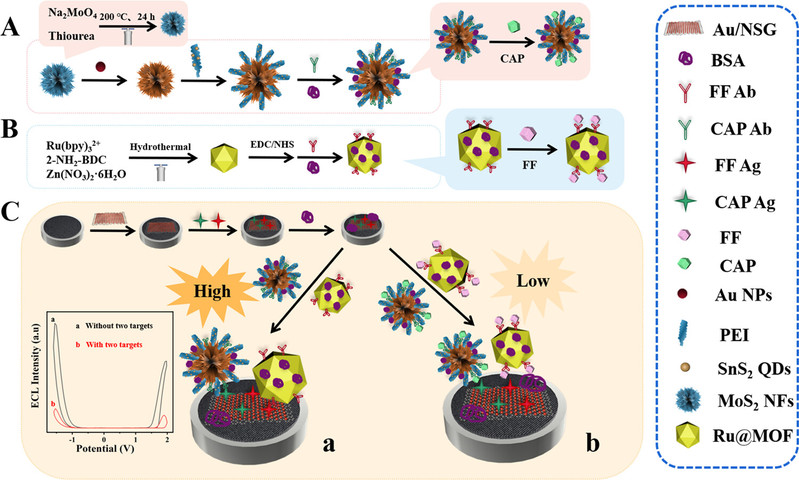Potential-Resolved Electrochemiluminescence Multiplex Immunoassay for Florfenicol and Chloramphenicol in a Single Sample
Yue Kong1, Xiaolin Fan1, Xun Yao2, Kang Wu3, Anping Deng1*(邓安平), Xinjian Feng1*(封心建), and Jianguo Li1*(李建国)
1The Key Laboratory of Health Chemistry & Molecular Diagnosis of Suzhou, College of Chemistry, Chemical Engineering & Materials Science, Soochow University, Suzhou 215123, P. R. China
2Comprehensive Technology Center of Zhangjiagang Customs, Zhangjiagang 215600 Jiangsu, P. R. China
3School of Biology & Basic Medical Science, Soochow University, Suzhou 215123, P. R. China
Anal. Chem. 2023, 95, 16639−16648
Abstract:The simultaneous detection of multiple antibiotic residues in food is of great significance for food safety. In this work, a novel dual-potential electrochemiluminescence (ECL) immunoassay was designed for the simultaneous detection of chloramphenicol and fluorfenicol residues in food. Ru@MOF was used as an anodic probe, and SnS2 QDs-PEI-Au-MoS2 was used as a cathodic probe. Notably, the coreactant for both luminophores was K2S2O8, avoiding interactions caused by different kinds of coreactants. Au nanoparticles functionalized with a nitrogen- and sulfur-doped graphene oxide-modified glassy carbon electrode to improve the electron transfer efficiency and provide a larger surface area for immobilization of antigen. The linear range for the detection of florfenicol was determined to be 0.1−1000 ng mL−1 with a detection limit of 0.03 ng mL−1 , and the linear range for the detection of chloramphenicol was 0.01−1000 ng mL−1 with a detection limit of 3.2 pg mL−1 by recording the ECL responses at two different excitation potentials. The proposed immunoassay achieved a more stable recovery in the detection of actual samples and provided a new analytical method for the simultaneous detection of florfenicol and chloramphenicol residues with high sensitivity and specificity.

链接://pubs.acs.org/doi/10.1021/acs.analchem.3c03019